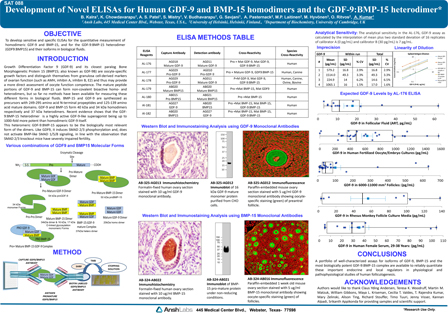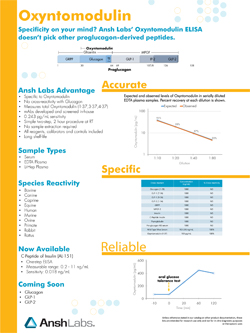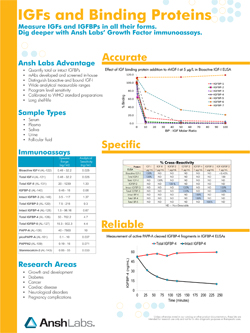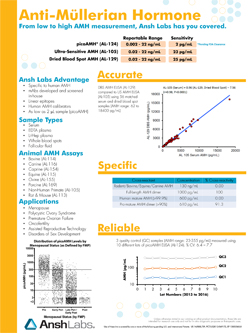Endo 2017 Review: GDF-9, BMP-15, and more
April 18, 2017
Endo 2017 Review: GDF-9, BMP-15, and more
It was great to see old friends and make new ones, visit with collaborators, and design new study programs to advance diagnostics and clinical research! At Endo 2017, Ansh Labs presented a scientific poster for a panel of GDF-9 and BMP-15 assays and monoclonal antibodies for immunoblot, IHC and IF applications, all in various sample types like follicular fluid, oocyte cultures and serum. We also displayed booth graphics on our AMH assays, IGF assays, and Oxyntomodulin. You can see all of them below.
Development of Novel ELISAs for Human GDF-9 and BMP-15 homodimers and the GDF-9:BMP-15 heterodimers
Growth Differentiation Factor 9 (GDF-9) and its closest paralog Bone Morphogenetic Protein 15 (BMP15; also known as GDF-9B) are oocyte-specific growth factors and distinguish themselves from granulosa cell-derived markers of ovarian function (such as AMH, inhibin A, inhibin B, E2) and thus may provide a more direct assessment of oocyte function competence. The mature  peptide portions of GDF-9 and BMP-15 can form non-covalent bioactive homo- and heterodimers, but so far no methods have been available for measuring these different forms in biological fluids. BMP-15 and GDF-9 are synthesized as precursors with 249-295 amino acid N-terminal propeptides and 125-139 amino acid mature domains. GDF-9 and BMP-15 form 40 kDa and 34 kDa homodimers respectively and 37 kDa heterodimers. Recent evidence shows that the GDF-9:BMP-15 heterodimer is a highly active GDF-9-like superagonist being up to 1000-fold more potent than homodimeric GDF-9 itself.
peptide portions of GDF-9 and BMP-15 can form non-covalent bioactive homo- and heterodimers, but so far no methods have been available for measuring these different forms in biological fluids. BMP-15 and GDF-9 are synthesized as precursors with 249-295 amino acid N-terminal propeptides and 125-139 amino acid mature domains. GDF-9 and BMP-15 form 40 kDa and 34 kDa homodimers respectively and 37 kDa heterodimers. Recent evidence shows that the GDF-9:BMP-15 heterodimer is a highly active GDF-9-like superagonist being up to 1000-fold more potent than homodimeric GDF-9 itself.
This heteromeric GDF-9:BMP-15 appears to be the biologically most relevant form of the dimers. Like GDF9, it induces SMAD 2/3 phosphorylation and, does not activate BMP-like SMAD 1/5/8 signaling, in line with the observation that SMAD 2/3 knockout mice have severely impaired fertility.
*Unless otherwise stated in our catalog or other company documentation accompanying Ansh Labs product(s), the products are intended for research use only (RUO) and not for in vitro diagnostic purposes.
Booth Graphic: OxyntomodulinExisting assays are not specific and reliable for accurate quantitation of Glucagon, Oxyntomodulin, and other related analytes. Ansh Labs worked closely with key opinion leaders in the field of glucagon regulation and screened countless antibodies to identify the best pair for Oxyntomodulin measurement. Backed by validation from several experts now we invite you to evaluate the oxyntomodulin ELISA and share your opinion with us. |
Booth Graphic: Growth FactorsBringing together Ansh Labs’ innovation and past expertise in developing IGF assays as Diagnostic Systems Laboratories (DSL), we are pleased to continue that hard-earned reputation with a full assay toolbox to evaluate IGF pathway components. Our panel of Growth factor immunoassays will allow you to measure IGFs and IGFBPs in all their forms allowing you to paint a complete picture of IGF pathway proteins in your research and diagnostic needs. |
Booth Graphic: Anti-Müllerian HormoneAnsh Labs is committed to developing new and novel assays for the investigation of hormones responsible for healthy ovary function including follicle recruitment, maturation, and dominant follicle selection. One of our key products, Anti-Mullerian Hormone (AMH) has been cited over 100 times in prestigious journals in just the last 24 months! Professionals have come to trust our picoAMH kit with its sensitivity of 2 pg/mL for their analyses in menopause and cancer. Our Dried Blood Spot AMH assay has developed a loyal following for those that need easier sample collection and transportation. |
*Unless otherwise stated in our catalog or other company documentation accompanying Ansh Labs product(s), the products are intended for research use only (RUO) and not for in vitro diagnostic purposes.


